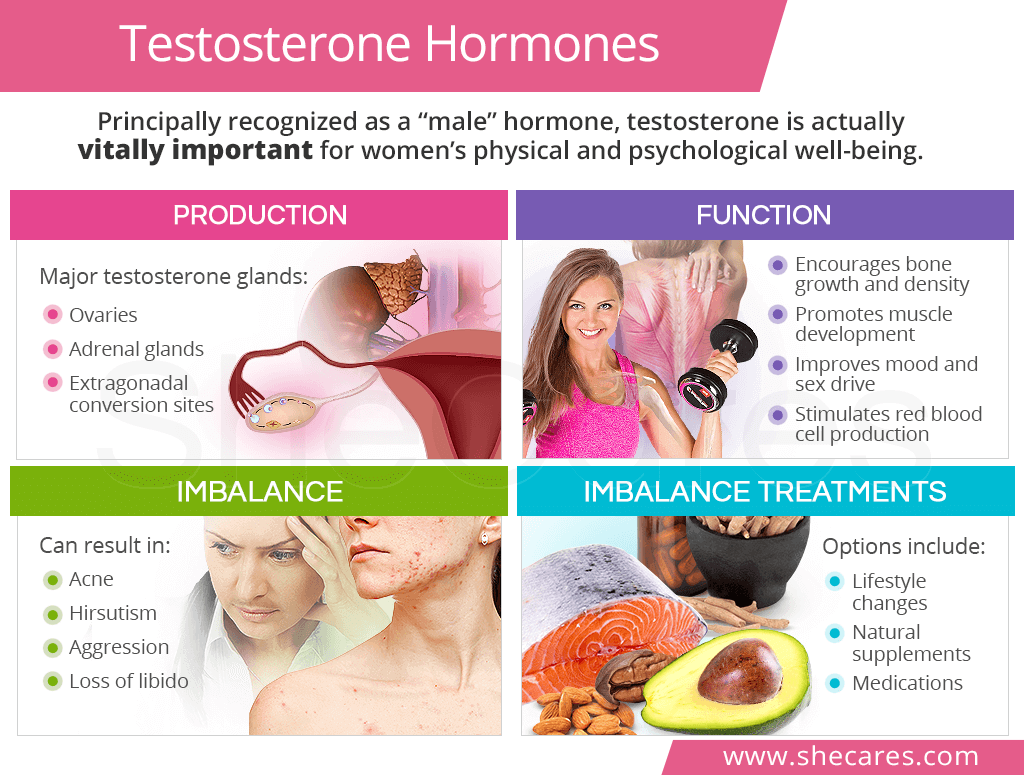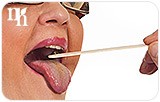What is Testosterone?
Testosterone is a sex steroid hormone that is a member of the androgen family. It stimulates the development of characteristics such as a healthy libido, toned muscle mass, among other functions in women.
Types of Testosterone
There are two main types of testosterone: natural and synthetic.
Natural testosterone is derived from cholesterol, while synthetic can be created in a laboratory and used to substitute endogenous steroidal testosterone.
Click on the following link to learn about testosterone, and the varying types of this commonly associated “male” hormone.
Testosterone Production
Testosterone Glands
Testosterone is largely produced by the ovaries and the adrenal glands. Unlike estrogen and progesterone, natural testosterone production from both sites will gradually decline with age but continue into postmenopause.
The steroid hormone can also be created from circulating precursors in peripheral tissues, like skin and fat tissues.
Testosterone Receptors
Once testosterone discovers a receptor site, it infiltrates and passes through the cell. Its entry will then create an assortment of cell reactions according to the amount of the hormone received.
Click on the following link to discover all about testosterone production, and finally have a better appreciation of the hormone's role within a woman's body.
Testosterone Function
Testosterone in women is necessary for their physical and psychological well-being, contributing to everything from a healthy circulatory system to reproductive ability and more.
Testosterone Roles
Apart from its principal reproductive roles, female testosterone carries out a range of other tasks that include:
- Encouraging bone growth and density
- Stimulating red blood cell production
- Promoting muscle development
- Upholding greater skin collagen content
- And more
Testosterone Effects
Moreover, healthy testosterone levels are felt across an arrangement of organs and body systems, such as the female reproductive tract; circulatory system; muscles and bones; breasts; skin; and brain.
To find out more imperative information regarding the hormone's continual contribution to female health and well-being, continue reading about testosterone roles and effects.
Testosterone Levels
Because of natural testosterone's ample involvement in driving the health of numerous body systems, it is imperative for women to keep normal testosterone levels.
During adulthood, healthy total testosterone levels range from 6 - 86 ng/dL. Women will have the highest amounts of testosterone up until their 30s, and levels fluctuate on a daily basis. During important reproductive stages, the hormone increases accordingly for more specific roles. Click on the following link to learn more about healthy testosterone levels.
Low Testosterone Levels
While it is natural for endogenous testosterone to decline with age, abnormally low levels for one's age group and reproductive stage could induce unpleasant traits. Low levels of testosterone for women can be due to natural causes, lifestyle factors, induced causes, and other conditions. Read more about low testosterone levels and causes that could be evoking unsightly symptoms.
Signs and Symptoms of Low Testosterone
At the same time, some women may not recognize that their symptoms are caused by low testosterone levels as they can be diverse and subtle. Symptoms and signs of low testosterone negatively impact not only the reproductive system, but also other body systems and organs. Learn more about the signs and symptoms of low testosterone levels before the imbalance turns into a disaster.
High Testosterone Levels
Oftentimes, women are more aware of increased levels of the steroid hormone in their bodies. Too much testosterone can be caused by periods of reproductive significance - such as pregnancy or parturition - as well as lifestyle factors, like excessive stress and alcohol consumption. They can also be due to treatments, medications, and health conditions, including polycystic ovary syndrome (PCOS), thyroid disorders, and insulin resistance, among others. Educate yourself more on the causes of high testosterone levels for increased awareness on how to avoid their disheartening effects.
Signs and Symptoms of High Testosterone
Oily skin, acne, female-pattern hair loss, and aggression are just a few of the many symptoms of high testosterone that can develop in women. If left unattended, they can manifest into more serious health conditions. Learn more about the signs and symptoms of high testosterone levels to be one step closer to ultimate hormonal equilibrium.
Testosterone Deficiency
A testosterone deficiency is distinct from low testosterone levels. A testosterone deficiency is incessant and long-lasting. Whereas, low testosterone levels are usually only temporary.
A permanent state of low testosterone, outside of the hormone's everyday fluctuations, often is result of abnormal gland function or exogenous hormone use. There are also several risk factors that can make women more apt to developing this hormonal imbalance. Learn all about causes, signs, and symptoms of a testosterone deficiency.
Testosterone Tests
In general, female testosterone tests are used to help investigate a number of health conditions, such as PCOS, virilization, or infertility.
Common Testosterone Tests
Many physicians use blood tests to measure total testosterone levels, or the amount of hormone in the body that is bound and unbound to proteins.
Another common - but less often used - testosterone test is the urine test. They are criticized for not being an accurate measure of free testosterone, which is not bound to proteins.
Advanced Testosterone Tests
On the other hand, a more advanced testosterone test is saliva testing. Even though they reflect free testosterone levels and allow women to self-test, some critics claim the results are easily influenced by numerous variables.
Discover more about testosterone tests for women, including when to take each for optimal results, by clicking on the preceding link.
Testosterone Medications & Products
Apart from the various lifestyle adjustments and natural treatments that can be implemented to remedy the imbalance, there are numerous pharmaceutical testosterone medications and products out on the market to help hasten treatment. Find out types and how to take testosterone medications, or continue on to the next sections for specifics about each.
Testosterone Pills
Testosterone pills, or testosterone tablets, are one of the most common forms of testosterone medications used by pre- and postmenopausal women alike to maintain a healthy libido, energy levels, and muscle mass, among other benefits. They are taken orally on a daily or every other day basis. Discover more about testosterone pills and their benefits and side effects.
Testosterone Gels & Creams
Testosterone gels and creams are liquid applications used to supplement the amount of testosterone in a woman's body. Similar to other medications, these gels and creams are used to improve well-being and sexual function. They should be applied directly to clean, dry surface of the skin on the thigh, arm, abdomen, clitoris, or labia. Read more about testosterone gels and creams in addition to their benefits and side effects by clicking on the preceding link.
Testosterone Injections
Testosterone injections are composed of synthetically created versions of the hormone to complement levels in the body. Common ones injected intramuscularly in postmenopausal women include testosterone enanthate or testosterone cypionate. Click on the following link to learn more about the far-reaching benefits and possible side effects of testosterone injections.
Testosterone Patches
Transdermal testosterone contains exogenous amounts of the steroid hormone. As such, these patches supply the body with sufficient amounts of testosterone when applied to the clean, dry areas of the skin on the back, abdomen, thighs, or upper arm. They are not generally prescribed to premenopausal women. Learn all about the many benefits and side effects of testosterone patches.
Testosterone Medication Side Effects
Many doctors are hesitant to prescribe testosterone to women due to its side effects, whose severity is often more pronounced than the symptoms of testosterone imbalance they're prescribed for. Although each of the aforementioned testosterone treatments has a specific list according to its particular use, there are general side effects for all. Read more about testosterone medication side effects here.
Lowering Testosterone Levels
Lifestyle changes in regards to diet as well as exercise and healthy habits are essential when lowering natural testosterone levels. Moreover, alternative treatments - such as vitamins, herbal supplements, and hormone-regulating supplements – as well as pharmaceutical options help decrease testosterone levels more quickly. Learn more about lowering testosterone before the condition worsens.
Increasing Testosterone Levels
Once a hormonal imbalance is diagnosed, there are methods women can use to increase testosterone levels, beginning with simple lifestyle changes of an enhanced diet, moderate resistance and strength training, and wholesome habits. Also, alternative medicine and pharmaceutical medications can hasten the process. Find out all about increasing testosterone to overcome the hormonal slump.
Testosterone Foods & Diet
Various testosterone foods have been scientifically researched to increase levels of the reproductive hormone in women's bodies, or they contain necessary nutrients needed to support the hormone's healthy levels. For increased success, these foods can be structured into an effective diet plan. Discover more about testosterone foods and diet to induce ultimate hormonal balance.
Natural Testosterone Supplements & Boosters
Alternative medicines offer little to no risk and can treat a hormonal imbalance directly at its source. They include vitamins and minerals - like magnesium and vitamin C - as well as herbs - such as ashwagandha and tribulus terrestris - and hormone-regulating supplements that naturally nourish endocrine glands, such as Macafem. Discover more about the various natural testosterone supplements and boosters that can be taken to finally stabilize hormones.
Sources
- Becker, K.L. et al. (2001). Principles and Practice of Endocrinology and Metabolism. Pennsylvania: Lippincott Williams & Wilkins. Available from Google Books.
- Chandrasekhar, K. et al. (2012). A Prospective, Randomized Double-Blind, Placebo-Controlled Study of Safety and Efficacy of a High-Concentration Full-Spectrum Extract of Ashwagandha Root in Reducing Stress and Anxiety in Adults. Indian Journal of Psychological Medicine, 34(3), 255-262. doi: 10.4103/0253-7176.106022
- De Souza, K.Z. et al. (2016). Efficacy of Tribulus terrestris for the treatment of hypoactive sexual desire disorder in postmenopausal women: a randomized, double-blinded, placebo-controlled trial. Menopause, 23(11), 1252-1256. doi: 10.1097/GME.0000000000000766
- Glaser, R. & Dimitrakakis, C. (2013). Testosterone therapy in women: Myths and misconceptions. Maturitas, 74(3), 230-234. doi: 10.1016/j.maturitas.2013.01.003
- McMaster Pathophysiology Review. (n.d.). Sex Hormone Synthesis, Regulation, and Function. Retrieved December 10, 2018, from http://www.pathophys.org/sexhormones/
- MedlinePlus. (2018). Ovarian overproduction of androgens. Retrieved December 10, 2018, from https://medlineplus.gov/ency/article/001165.htm
- Seelig, M.S. & Rosanoff, A. (2003). The Magnesium Factor. New York: Avery. Available from Google Books.
- Society for Endocrinology. (2018). Testosterone | Androstenedione. Retrieved June 13, 2018, from http://www.yourhormones.info/hormones/testosterone.aspx | http://www.yourhormones.info/hormones/androstenedione/
- University of Iowa Health Care. (2016). Testosterone, Free and Total, Adult. Retrieved December 10, 2018, from https://www.healthcare.uiowa.edu/path_handbook/handbook/test1802.html










